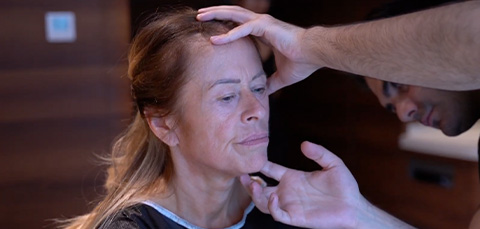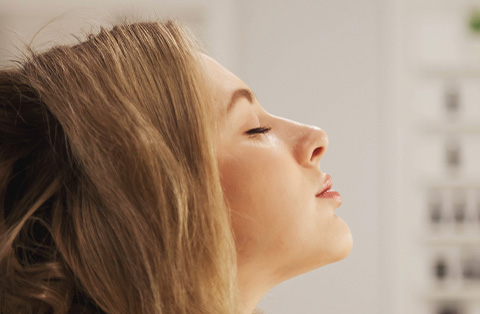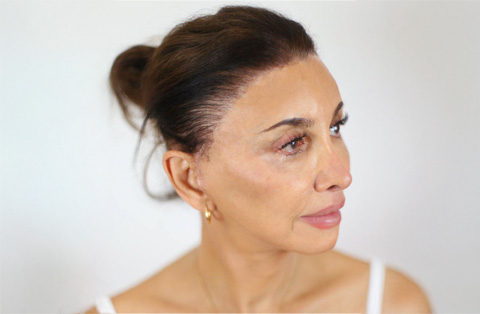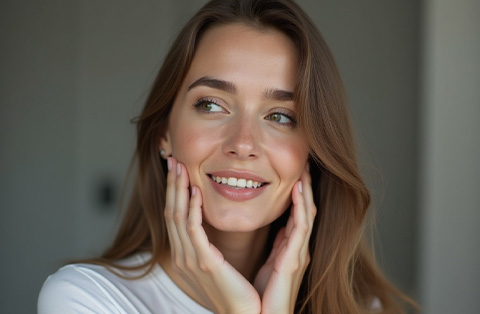Seeking a transformative change with lasting results? Delve into the world of deep plane facelift in Turkey, a gold standard in facial rejuvenation. With cost-effective solutions, Turkey stands as a beacon for those prioritizing both quality and affordability.
Here, you’ll find insights on the deep plane facelift cost in Turkey and get acquainted with the best deep plane facelift surgeons in the country. Navigate our comprehensive guide and make an informed choice for your aesthetic journey.
What is a Facelift?
A facelift, also known as rhytidectomy, is a facial rejuvenation procedure that involves excess skin and fat removal, and muscle and tissue tightening.
There are several facelift techniques, each designed to address specific aging concerns and areas of the face.
What is a Deep Plane Facelift?
A deep plane facelift is a sophisticated surgical technique that targets the deeper layers of facial tissues, specifically the Superficial Musculo Aponeurotic System (SMAS) and the muscles beneath it. Unlike traditional facelifts that primarily tighten the skin, the deep plane facelift goes further by repositioning the underlying muscles and connective tissue. This results in a more natural and longer-lasting rejuvenation with reduced tension on the skin.
The procedure is particularly effective in addressing sagging around the midface, jowls, and neck, offering a holistic rejuvenation. It aims to restore a youthful contour to the face without the “pulled” look that can sometimes result from less advanced techniques. Given its in-depth approach, the deep plane facelift often produces more profound and natural-looking results compared to its counterparts.
What are the different layers of the face?
Understanding the intricate anatomy of the face is pivotal in comprehending how facelift procedures function and how the diverse facelift techniques differ. The facial structure consists of several unique layers, each contributing to our appearance and how our face ages. Moving from the exterior to the interior, these layers comprise:
- Skin and Superficial Fat Layer: This is the outermost covering of the face. It’s primarily responsible for the face’s texture, tone, and initial signs of aging, such as wrinkles and fine lines.
- The SMAS Layer: Short for the Superficial Musculoaponeurotic System, this distinct fibromuscular tissue layer envelops the face. It plays a pivotal role in the aging process and is a critical target in many facelift techniques to achieve youthful and long-lasting results.
- Deep Facial Plane: Positioned beneath the SMAS, this plane houses the facial ligaments and muscles that are essential for facial movements and expressions. Aging at this level can result in deeper folds and sagging.
While this overview provides a simplified depiction of the facial anatomy, it serves as a foundational guide to understanding the nuances and objectives of various facelift procedures. Knowing these layers helps patients and surgeons make informed decisions regarding the most appropriate technique for individual needs.
How Does a Deep Plane Facelift Work?
This innovative procedure works by lifting the deeper layers of facial tissues (the SMAS and the muscles), not just the skin. By targeting this deep plane, it reduces sagging, minimizes deep wrinkles, and enhances the contours of the face.
Deep plane facelift procedure
At our esteemed hospitals in Istanbul, we undertake the intricate deep plane facelift procedure. Let’s delve into the step-by-step process of how this transformative surgery unfolds:
Setting & Anesthesia:
The surgery is executed under general anesthesia, ensuring the patient’s comfort throughout. Depending on the surgery’s complexity and any additional procedures, such as eyelid surgery, the deep plane facelift can last between 2 to 4 hours.
Incisions:
The procedure commences with skin incisions strategically made at the front of the ear, extending downward towards the earlobe. This incision curves upwards around the ear, leading into the posterior hairline, ensuring symmetry, identical incisions are made on both sides of the face.
Deep Dissection:
The core of the procedure involves a detailed dissection beneath the SMAS layer. This action exposes the deepest layers of facial tissue, allowing the surgeon to work with precision.
Addressing Facial Ligaments:
Stretched facial ligaments are carefully separated from their original placements. Each is then meticulously tightened and sutured higher on the face. By focusing on individual facial ligaments, the procedure assures a comprehensive tightening and uplifting of the deep facial muscle layer.
Correcting Jowls:
Any protruding fat leading to jowl formation is rectified during the surgery, ensuring a smoother jawline and facial contour.
Repositioning the SMAS:
The SMAS layer, once accessed, is anchored to a higher position, resulting in a pronounced upliftment of sagging facial tissues.
Skin Tightening:
Excess and sagging skin is surgically trimmed. The remaining skin is meticulously tightened, erasing wrinkles and refining the contours of the lower face and jawline.
Closure:
The procedure concludes with the incisions being sealed using dissolvable stitches. These are strategically placed within natural skin folds, minimizing visible scarring.
Post-Procedure Care:
The surgery is scheduled early in the day, allowing ample recovery time in our dedicated unit. After post-operative monitoring and an evening consultation with the surgeon, patients are discharged. However, it’s imperative to stay locally, preferably in a nearby hotel, for prompt attention to potential complications.
Additionally, an adult is required to assist the patient during the initial post-operative days.
By understanding each phase of this procedure, one can appreciate the meticulousness involved in achieving a rejuvenated facial appearance.
Targeted Areas
Operation primarily targets the mid-face, cheeks, and the lower face, including the jowls and neck. It’s particularly effective at correcting deep nasolabial folds and marionette lines.
Benefits of Deep Plane Facelift
The deep plane facelift is a refined surgical technique that targets the deeper facial structures to deliver rejuvenating effects. Here are the detailed benefits of this advanced procedure:
- Natural-Looking Results: One of the most significant advantages of the deep plane facelift is its ability to produce natural-looking outcomes. By repositioning the deeper facial layers rather than merely tightening the skin, the results avoid the stretched or “windblown” appearance that can sometimes occur with other methods.
- Long-Lasting Effects: Given that this procedure addresses the deeper layers of the face, the results tend to be longer-lasting than those from superficial techniques. Many patients enjoy the benefits of a deep plane facelift for a decade or more.
- Comprehensive Rejuvenation: This method treats multiple signs of aging simultaneously. By lifting and repositioning the SMAS and deeper facial tissues, it effectively addresses jowls, sagging cheeks, and nasolabial folds.
- Reduced Skin Tension: Since the lifting is accomplished at a deeper level, there’s less tension on the skin during closure, potentially leading to better healing and less noticeable scarring.
- Preservation of Facial Expression: By working with the deeper facial layers, the deep plane facelift preserves the natural movement and expressions of the face, ensuring patients still look like themselves post-surgery, only more refreshed.
- Compatibility with Other Procedures: The deep plane facelift can be combined seamlessly with other cosmetic procedures, such as eyelid surgery or brow lift, for a comprehensive facial rejuvenation.
- Less Risk of Skin Irregularities: Since the skin isn’t being overly tightened or separated from the underlying structures, there’s a reduced risk of surface irregularities like rippling or lumpiness.
- Enhanced Neck Contouring: The technique can extend into the neck, offering improved neck contouring and addressing issues like sagging skin and prominent muscle bands.
Choosing the deep plane facelift means investing in a technique known for its sophisticated approach and favorable results. However, it’s essential to work with a qualified and experienced surgeon proficient in the method to ensure optimal outcomes and a safe procedure.
Good Candidates for a Deep Plane Facelift?
Deciding on undergoing a facelift, particularly the deep plane technique, requires a thorough evaluation. Here are some criteria and considerations to determine if you might be a good candidate for a deep plane facelift:
- Age and Skin Elasticity: While there’s no specific age cut-off for a deep plane facelift, most candidates are typically in their 40s to 60s. At this stage, many individuals begin to experience noticeable sagging of the deeper facial structures. Skin elasticity is also crucial; even though the procedure addresses the deeper layers, having some degree of skin flexibility can enhance results.
- Signs of Advanced Aging: Those who benefit the most from a deep plane facelift are individuals with pronounced sagging around the mid-face, deep nasolabial folds, jowls, and a slack jawline. This technique is particularly effective for these concerns.
- General Health: As with any surgery, being in good overall health is vital. Patients should be free from conditions that could complicate surgery or recovery. A detailed medical history and possibly some medical tests will be necessary to assess this.
- Non-Smokers or Willing to Quit Temporarily: Smoking can severely impair the healing process. Suitable candidates should either be non-smokers or be willing to quit several weeks before and after the surgery to ensure proper healing.
- Realistic Expectations: It’s essential to have a clear understanding and realistic expectations of what a deep plane facelift can and cannot achieve. While it offers profound rejuvenation, it doesn’t stop the aging process.
- Previous Surgeries: If you’ve had prior facelifts or other facial surgeries, your surgeon will need to evaluate your face’s anatomical changes to determine if a deep plane facelift is feasible or beneficial.
- Emotional Stability: Undergoing cosmetic surgery can be emotionally taxing. It’s crucial to be emotionally stable, understand the recovery process, and be prepared for the temporary swelling and bruising that follows the procedure.
- Professional Consultation: Ultimately, the best way to determine your suitability for a deep plane facelift is through a professional consultation with a skilled and experienced plastic surgeon who specializes in this technique. They can provide a personalized assessment based on your facial anatomy, concerns, and desired outcomes.
Remember, while a deep plane facelift offers numerous advantages, it’s not a one-size-fits-all solution. A thorough evaluation will ensure that the chosen procedure aligns with your aesthetic goals and medical profile.
Risks & Complications of Deep Plane Facelift Surgery
This procedure is considered to be very safe when performed by an experienced facelift surgeon in Turkey. Having said that, all types of surgery involve certain risks, and then once specific to this procedure, include:
- Bleeding and haematoma formation
- Seroma or fluid collection beneath the skin.
- Wound infection
- Injury to branches of the facial nerve.
- Salivary gland or duct injury.
It’s of utmost importance to select an experienced and board-certified surgeon for a deep plane facelift to minimize potential risks. An open dialogue with the surgeon about expectations, concerns, and post-operative care is crucial for a successful outcome.
How Much Does a Deep Plane Facelift Cost?
The cost varies, depending on the specifics of the surgery and the surgeon’s expertise. In the US, it typically ranges between $10,000 and $25,000.
Check out Facelift Surgery costs in UK vs. Turkey in detail.
Deep Plane Facelift Cost in Turkey
Turkey is renowned for its high-quality healthcare and experienced surgeons. Deep plane facelifts are available at more affordable prices in Turkey. These procedures usually cost between $3,000 and $7,000, which includes both pre and post-operative care.
Related: Is It Safe to Get Plastic Surgery in Turkey?
Recovery Timeline After a Deep Plane Facelift Surgery
Recovering from a deep plane facelift is a process that involves several stages. Each individual’s healing trajectory may vary slightly, but the following offers a general timeline for what most patients can expect:
Immediate Post-Operation (Day 1-3):
- Swelling and Bruising: These are most prominent in the first 72 hours. Cool compresses can help alleviate swelling.
- Discomfort: Mild to moderate pain might be present, managed effectively with prescribed painkillers.
Dressings and Drains: Surgical dressings are usually in place, and some surgeons might use drains to prevent fluid accumulation.
End of First Week:
- Reduced Swelling: By the end of the week, a significant reduction in swelling and bruising is noticed.
- Stitch Removal: If non-dissolvable stitches are used, they are typically removed 5-7 days post-operation.
Mobility: Most patients feel up to light activities, but strenuous exercises and heavy lifting are strictly off-limits.
Second Week:
- Continued Healing: Most of the noticeable swelling subsides by the end of the second week.
- Facial Sensation: Some numbness or tingling might be felt; this is a natural part of the healing process.
Appearance: While the face is still in the healing phase, many patients feel confident enough for social activities or returning to work by the end of this week.
One Month Post-Operation:
- Almost Normal: Most patients feel nearly “back to normal” with only minor tightness or numbness.
- Resuming Activities: Regular activities, including mild exercises, can usually be resumed, but always consult with your surgeon.
- Visible Results: The beneficial effects of the surgery are becoming more evident as the face continues to settle.
Three Months and Beyond:
- Final Contouring: The face should have settled into its new contours, with maximum swelling resolved.
- Scar Maturation: While incisions are usually well-hidden, any remaining redness or firmness in scars will continue to fade. Scar care, as advised by the surgeon, can optimize this process.
- Full Activities: All forms of exercises, including strenuous ones, can usually be resumed.
Six Months to One Year:
- Complete Recovery: Any residual tightness or irregularities generally resolve during this period.
- Optimal Results: The face should now fully reflect the rejuvenated and refreshed appearance aimed for with the surgery.
Throughout the recovery process, periodic check-ups with the surgeon are essential to monitor healing and address any concerns. It’s crucial to strictly adhere to post-operative care guidelines to ensure the best possible outcome and minimize complications.
Before and After Pictures of Deep Plane Facelift



Here is a good example of a deep plane facelift in Turkey before and after. A deep plane procedure is the most in-depth, thorough kind of facial rejuvenation. We are particularly proud of this rare achievement. Our patient achieved a solid 20-year younger appearance through successful skin stretching.
Explore our gallery to see the transformative results our expert surgeons achieve. You can check our Plastic Surgery Before After page or contact us to see special Deep Plane Facelift results.
List of Other Facelift Procedures
We also offer other facelift procedures such as:
How to Choose the Best Facelift Technique?
The best technique depends on your unique needs and goals. Our experienced surgeons can help you choose the right procedure during a consultation.
Don’t let aging signs define you. Contact us today to learn more about how a deep plane facelift can help you rejuvenate your look.
All Facelift Techniques & Types Guide
FAQ
What to expect after the surgery?
After the surgery, expect some swelling and bruising, which will diminish over time. Final results appear within a few months.
How long does Deep Plane Facelift last?
Deep plane facelift results can last up to 10-15 years, depending on individual factors such as lifestyle and genetics.
Is deep plane better than regular facelift?
It depends on individual needs. It can achieve more comprehensive and natural-looking results, particularly for those with advanced signs of aging.
What is the average age for a deep plane facelift?
The procedure is commonly performed on individuals in their 50s to 70s, but it ultimately depends on the person’s facial aging.
Which country is best for deep plane facelift?
The quality of a deep plane facelift largely depends on the surgeon’s experience and skills, rather than the country. However, some countries have gained a reputation for excellent outcomes in plastic surgery.
Turkey, in particular, has emerged as a prominent destination for health tourism, attracting patients from across the globe. It boasts highly experienced surgeons who specialize in the deep plane facelift technique. These medical professionals not only have extensive training and practice, but also adhere to international surgical standards.
In addition to the surgeons’ expertise, Turkey is known for its state-of-the-art hospitals. These institutions are equipped with advanced technologies and facilities, providing high-quality medical services.
Moreover, the cost of a deep plane facelift in Turkey is typically more affordable than in many other countries, making it a popular choice for those seeking top-tier medical services without breaking the bank.
However, also noteworthy are countries like the US and Brazil, known for their high standards in cosmetic surgery. Nonetheless, given the blend of quality, affordability, and modern healthcare infrastructure, Turkey stands out as a preferred choice for deep plane facelifts.
How painful is a deep plane facelift?
Postoperative discomfort can be managed with medication and typically subsides within a few days.
Does a deep plane facelift look natural?
Yes, by lifting deeper structures, the operation offers more natural and long-lasting results.
How much younger does a deep plane facelift make you look?
While individual results vary, many patients report looking 10-15 years younger.
Can you have 2 deep plane facelifts?
It’s possible to have a second procedure years later if desired.
Does deep plane facelift lift cheeks?
Yes, it is particularly effective at lifting sagging cheeks.
How long does it take to fully recover from a deep plane facelift?
Full recovery can take 2-4 weeks, with most patients resuming normal activities after 2 weeks.
Does a deep plane facelift improve the neck?
Yes, the procedure can significantly improve sagging and excess skin in the neck area. But it is possible to be combined with a neck lift surgery.
Is deep plane facelift safe?
When performed by an experienced, board-certified surgeon, this surgery is considered safe.
How long does a deep plane facelift take?
The surgery typically takes 4-6 hours.
Is a deep plane facelift worth it?
For many people seeking comprehensive facial rejuvenation, it is a worthwhile investment.






